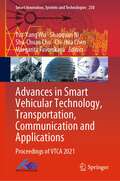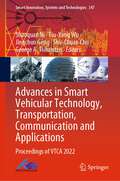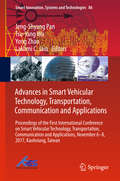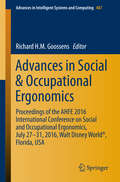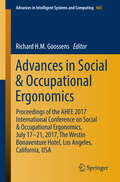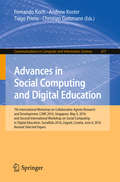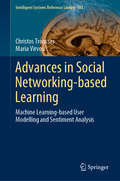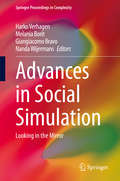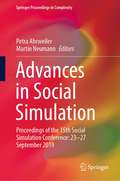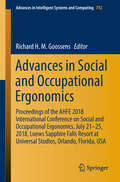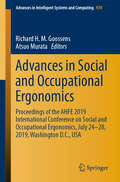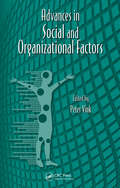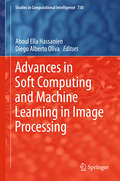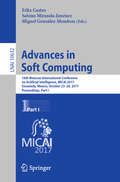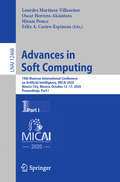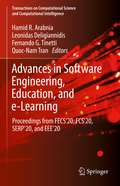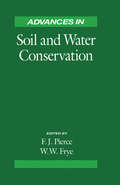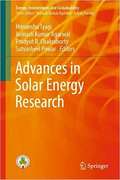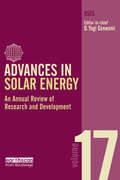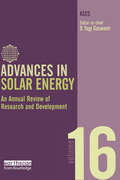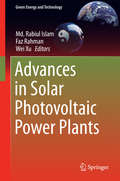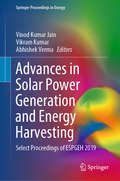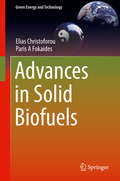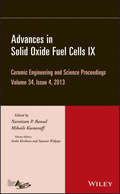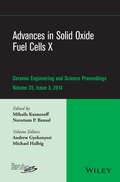- Table View
- List View
Advances in Smart Vehicular Technology, Transportation, Communication and Applications: Proceedings of VTCA 2021 (Smart Innovation, Systems and Technologies #250)
by Shu-Chuan Chu Margarita Favorskaya Tsu-Yang Wu Shaoquan Ni Chi-Hua ChenThis book includes selected papers from the fourth International Conference on Smart Vehicular Technology, Transportation, Communication and Applications (VTCA 2021), held in Chengdu City, Sichuan Province, China, during May 22–24, 2021. The conference is technically co-sponsored by Southwest Jiaotong University, Shandong University of Science and Technology, Fujian University of Technology, and Minjiang University. The book includes research works from engineers, researchers, and practitioners interested in the advances and applications in the field of vehicle technology and communication. The book covers four tracks, namely (1) vehicular networking security, (2) vehicular electronics, (3) intelligent transportation systems, and (4) smart vehicular communication networks and telematics.
Advances in Smart Vehicular Technology, Transportation, Communication and Applications: Proceedings of VTCA 2022 (Smart Innovation, Systems and Technologies #347)
by George A. Tsihrintzis Shu-Chuan Chu Tsu-Yang Wu Shaoquan Ni Jingchun GengThis book includes selected papers from the fifth International Conference on Smart Vehicular Technology, Transportation, Communication and Applications (VTCA 2022), held in online mode during December 24–26, 2022. The book includes research works from engineers, researchers, and practitioners interested in the advances and applications in the field of vehicle technology and communication. The book covers four tracks, namely (1) vehicular networking security, (2) vehicular electronics, (3) intelligent transportation systems and applications, and (4) smart vehicular communication networks and telematics.
Advances in Smart Vehicular Technology, Transportation, Communication and Applications: Proceedings of the First International Conference on Smart Vehicular Technology, Transportation, Communication and Applications, November 6-8, 2017, Kaohsiung, Taiwan (Smart Innovation, Systems and Technologies #86)
by Lakhmi C. Jain Jeng-Shyang Pan Yong Zhao Tsu-Yang WuThis book presents papers from the First International Conference on Smart Vehicular Technology, Transportation, Communication and Applications (VTCA 2017). Held from 6 to 8 November 2017 in Kaohsiung, Taiwan, the conference was co-sponsored by Springer, Fujian University of Technology in China, Fujian Provincial Key Laboratory of Digital Equipment, Fujian Provincial Key Lab of Big Data Mining and Applications, and National Kaohsiung University of Applied Sciences in Taiwan. The book is a valuable resource for researchers and professionals engaged in all areas of smart vehicular technology, vehicular transportation, vehicular communication, and applications.
Advances in Social & Occupational Ergonomics: Proceedings of the AHFE 2016 International Conference on Social and Occupational Ergonomics, July 27-31, 2016, Walt Disney World®, Florida, USA (Advances in Intelligent Systems and Computing #487)
by Richard H.M. GoossensThis book reports on cutting-edge research related to social and occupational factors. It presents innovative contributions to the optimization of sociotechnical management systems, which consider organizational, policy, and logistical issues. It discusses timely topics related to communication, crew resource management, work design, participatory design, as well as teamwork, community ergonomics, cooperative work, and warning systems. Moreover, it reports on new work paradigms, organizational cultures, virtual organizations, telework, and quality management. The book reports on cutting-edge infrastructures implemented for different purposes such as urban, health, and enterprise. It discusses the growing role of automated systems and presents innovative solutions addressing the needs of special populations. Based on the AHFE 2016 International Conference on Social and Occupational Ergonomics, held on July 27-31 in Walt Disney World(r), Florida, USA, the book provides readers with a comprehensive view of the current challenges in both organizational and occupational ergonomics, highlighting key connections between them and underlining the importance of emotional factors in influencing human performance.
Advances in Social & Occupational Ergonomics: Proceedings of the AHFE 2017 International Conference on Social & Occupational Ergonomics, July 17-21, 2017, The Westin Bonaventure Hotel, Los Angeles, California, USA (Advances in Intelligent Systems and Computing #605)
by Richard H. M. GoossensThis book reports on cutting-edge research related to social and occupational factors. It presents innovative contributions to the optimization of sociotechnical management systems, which consider organizational, policy, and logistical issues. It discusses timely topics related to communication, crew resource management, work design, participatory design, as well as teamwork, community ergonomics, cooperative work, and warning systems. Moreover, it reports on new work paradigms, organizational cultures, virtual organizations, telework, and quality management. The book reports on cutting-edge infrastructures implemented for different purposes such as urban, health, and enterprise. It discusses the growing role of automated systems and presents innovative solutions addressing the needs of special populations. Based on the AHFE 2016 International Conference on Social and Occupational Ergonomics, held on July 27-31 in Walt Disney World(r), Florida, USA, the book provides readers with a comprehensive view of the current challenges in both organizational and occupational ergonomics, highlighting key connections between them and underlining the importance of emotional factors in influencing human performance.
Advances in Social Computing and Digital Education: 7th International Workshop on Collaborative Agents Research and Development, CARE 2016, Singapore, May 9, 2016 and Second International Workshop on Social Computing in Digital Education, SocialEdu 2016, Zagreb, Croatia, June 6, 2016, Revised Selected Papers (Communications in Computer and Information Science #677)
by Fernando Koch Christian Guttmann Andrew Koster Tiago PrimoThis book constitutes the refereed proceedings of the 7th International Workshop on Collaborative Agents Research and Development, CARE 2016, held in Singapore in May 2016 and Second International Workshop on Social Computing in Digital Education, SocialEdu 2016, held in Zagreb, Croatia, in June 2016. For CARE 2016 there were 4 papers selected out of 7 submissions, and for SocialEdu 5 papers were selected from 7 submissions. The 9 extended and revised full papers presented were carefully reviewed. The papers deal with topics like techniques of continuous monitoring, human behaviour analysis, recommendation systems, adjustment of education activities, intelligent content placement, and others.
Advances in Social Networking-based Learning: Machine Learning-based User Modelling and Sentiment Analysis (Intelligent Systems Reference Library #181)
by Maria Virvou Christos TroussasThis book discusses three important, hot research issues: social networking-based learning, machine learning-based user modeling and sentiment analysis. Although these three technologies have been widely used by researchers around the globe by academic disciplines and by R&D departments in the IT industry, they have not yet been used extensively for the purposes of education. The authors present a novel approach that uses adaptive hypermedia in e-learning models to personalize educational content and learning resources based on the needs and preferences of individual learners. According to reports, in 2018 the vast majority of internet users worldwide are active on social networks, and the global average social network penetration rate as of 2018 is close to half the population. Employing social networking technologies in the field of education allows the latest technological advances to be used to create interactive educational environments where students can learn, collaborate with peers and communicate with tutors while benefiting from a social and pedagogical structure similar to a real class. The book first discusses in detail the current trend of social networking-based learning. It then provides a novel framework that moves further away from digital learning technologies while incorporating a wide range of recent advances to provide solutions to future challenges. This approach incorporates machine learning to the student-modeling component, which also uses conceptual frameworks and pedagogical theories in order to further promote individualization and adaptivity in e-learning environments. Moreover, it examines error diagnosis, misconceptions, tailored testing and collaboration between students are examined and proposes new approaches for these modules. Sentiment analysis is also incorporated into the general framework, supporting personalized learning by considering the user’s emotional state, and creating a user-friendly learning environment tailored to students’ needs. Support for students, in the form of motivation, completes the framework. This book helps researchers in the field of knowledge-based software engineering to build more sophisticated personalized educational software, while retaining a high level of adaptivity and user-friendliness within human–computer interactions. Furthermore, it is a valuable resource for educators and software developers designing and implementing intelligent tutoring systems and adaptive educational hypermedia systems.
Advances in Social Simulation: Looking in the Mirror (Springer Proceedings in Complexity)
by Harko Verhagen Melania Borit Giangiacomo Bravo Nanda WijermansThis book presents the state-of-the-art in social simulation as presented at the Social Simulation Conference 2018 in Stockholm, Sweden. It covers the developments in applications and methods of social simulation, addressing societal issues such as socio-ecological systems and policy making. Methodological issues discussed include large-scale empirical calibration, model sharing and interdisciplinary research, as well as decision making models, validation and the use of qualitative data in simulation modeling. Research areas covered include archaeology, cognitive science, economics, organization science, and social simulation education.This collection gives readers insight into the increasing use of social simulation in both its theoretical development and in practical applications such as policy making whereby modelling and the behavior of complex systems is key. The book will appeal to students, researchers and professionals in the various fields.
Advances in Social Simulation: Proceedings of the 15th Social Simulation Conference: 23–27 September 2019 (Springer Proceedings in Complexity)
by Martin Neumann Petra AhrweilerThis book presents the state of the art in social simulation as presented at the Social Simulation Conference 2019 in Mainz, Germany. It covers the developments in applications and methods of social simulation, addressing societal issues such as socio-ecological systems and policymaking. Methodological issues discussed include large-scale empirical calibration, model sharing and interdisciplinary research, as well as decision-making models, validation and the use of qualitative data in simulation modeling. Research areas covered include archaeology, cognitive science, economics, organization science and social simulation education.This book gives readers insight into the increasing use of social simulation in both its theoretical development and in practical applications such as policymaking whereby modeling and the behavior of complex systems is key. The book appeals to students, researchers and professionals in the various fields.
Advances in Social and Occupational Ergonomics: Proceedings of the AHFE 2018 International Conference on Social and Occupational Ergonomics, July 21-25, 2018, Loews Sapphire Falls Resort at Universal Studios, Orlando, Florida, USA (Advances in Intelligent Systems and Computing #792)
by Richard H. GoossensThis book reports on cutting-edge research on social and occupational ergonomics, presenting innovative contributions to the optimization of sociotechnical management systems related to organizational, policy, and logistical issues. It discusses timely topics related to communication, crew resource management, work design, participatory design, as well as teamwork, community ergonomics, cooperative work, and warning systems, and explores new work paradigms, organizational cultures, virtual organizations, telework, and quality management. The book also describes pioneering infrastructures implemented for different purposes such as urban, health, and enterprise, and examines the changing role of automated systems, offering innovative solutions that address the needs of particular populations. Based on the AHFE 2018 International Conference on Social and Occupational Ergonomics, held in Orlando, Florida, USA on July 21–25, 2018, the book provides readers with a comprehensive overview of the current challenges in both organizational and occupational ergonomics, highlighting key connections between them and underlining the importance of emotional factors in influencing human performance.
Advances in Social and Occupational Ergonomics: Proceedings of the AHFE 2019 International Conference on Social and Occupational Ergonomics, July 24-28, 2019, Washington D.C., USA (Advances in Intelligent Systems and Computing #970)
by Richard H.M. Goossens Atsuo MurataThis book reports on cutting-edge research on social and occupational ergonomics, presenting innovative contributions to the optimization of sociotechnical management systems related to organizational, policy, and logistical issues. It discusses timely topics related to communication, crew resource management, work design, participatory design, as well as teamwork, community ergonomics, cooperative work, and warning systems, and explores new work paradigms, organizational cultures, virtual organizations, telework, and quality management. The book also describes pioneering infrastructures implemented for different purposes such as urban, health, and enterprise, and examines the changing role of automated systems, offering innovative solutions that address the needs of particular populations. Based on the AHFE 2019 International Conference on Social and Occupational Ergonomics, held on July 24-28, 2019, Washington D.C, USA, the book provides readers with a comprehensive overview of the current challenges in both organizational and occupational ergonomics, highlighting key connections between them and underlining the importance of emotional factors in influencing human performance.
Advances in Social and Organizational Factors
by Peter VinkAn in depth review of social ergonomics- also known as organizational ergonomics- this book discusses the optimization of sociotechnical systems, including their organizational structures, policies, and processes. The relevant topics include communication, crew resource management, work design, design of working times, teamwork, participatory design, community ergonomics, cooperative work, new work paradigms, organizational culture, virtual organizations, telework, and quality management.
Advances in Soft Computing and Machine Learning in Image Processing (Studies in Computational Intelligence #730)
by Aboul Ella Hassanien Diego Alberto OlivaThis book is a collection of the latest applications of methods from soft computing and machine learning in image processing. It explores different areas ranging from image segmentation to the object recognition using complex approaches, and includes the theory of the methodologies used to provide an overview of the application of these tools in image processing. The material has been compiled from a scientific perspective, and the book is primarily intended for undergraduate and postgraduate science, engineering, and computational mathematics students. It can also be used for courses on artificial intelligence, advanced image processing, and computational intelligence, and is a valuable resource for researchers in the evolutionary computation, artificial intelligence and image processing communities.
Advances in Soft Computing: 16th Mexican International Conference on Artificial Intelligence, MICAI 2017, Enseneda, Mexico, October 23-28, 2017, Proceedings, Part I (Lecture Notes in Computer Science #10632)
by Sabino Miranda-Jiménez Félix Castro Miguel González-MendozaThe two-volume set LNAI 10632 and 10633 constitutes the proceedings of the 16th Mexican International Conference on Artificial Intelligence, MICAI 2017, held in Enseneda, Mexico, in October 2017. The total of 60 papers presented in these two volumes was carefully reviewed and selected from 203 submissions. The contributions were organized in the following topical sections: Part I: neural networks; evolutionary algorithms and optimization; hybrid intelligent systems and fuzzy logic; and machine learning and data mining. Part II: natural language processing and social networks; intelligent tutoring systems and educational applications; and image processing and pattern recognition.
Advances in Soft Computing: 19th Mexican International Conference on Artificial Intelligence, MICAI 2020, Mexico City, Mexico, October 12–17, 2020, Proceedings, Part I (Lecture Notes in Computer Science #12468)
by Oscar Herrera-Alcántara Lourdes Martínez-Villaseñor Hiram Ponce Félix A. Castro-EspinozaThe two-volume set LNAI 12468 and 12469 constitutes the proceedings of the 19th Mexican International Conference on Artificial Intelligence, MICAI 2020, held in Mexico City, Mexico, in October 2020. The total of 77 papers presented in these two volumes was carefully reviewed and selected from 186 submissions. The contributions are organized in topical as follows: Part I: machine and deep learning, evolutionary and metaheuristic algorithms, and soft computing. Part II: natural language processing, image processing and pattern recognition, and intelligent applications and robotics.
Advances in Software Engineering, Education, and e-Learning: Proceedings from FECS'20, FCS'20, SERP'20, and EEE'20 (Transactions on Computational Science and Computational Intelligence)
by Hamid R. Arabnia Quoc-Nam Tran Leonidas Deligiannidis Fernando G. TinettiThis book presents the proceedings of four conferences: The 16th International Conference on Frontiers in Education: Computer Science and Computer Engineering + STEM (FECS'20), The 16th International Conference on Foundations of Computer Science (FCS'20), The 18th International Conference on Software Engineering Research and Practice (SERP'20), and The 19th International Conference on e-Learning, e-Business, Enterprise Information Systems, & e-Government (EEE'20). The conferences took place in Las Vegas, NV, USA, July 27-30, 2020 as part of the larger 2020 World Congress in Computer Science, Computer Engineering, & Applied Computing (CSCE'20), which features 20 major tracks. Authors include academics, researchers, professionals, and students. This book contains an open access chapter entitled, "Advances in Software Engineering, Education, and e-Learning".Presents the proceedings of four conferences as part of the 2020 World Congress in Computer Science, Computer Engineering, & Applied Computing (CSCE'20);Includes the tracks Computer Engineering + STEM, Foundations of Computer Science, Software Engineering Research, and e-Learning, e-Business, Enterprise Information Systems, & e-Government;Features papers from FECS'20, FCS'20, SERP'20, EEE'20, including one open access chapter.
Advances in Soil and Water Conservation
by Francis J. PierceAdvances in Soil and Water Conservation provides an in-depth, scholarly treatment of the most important developments and influences shaping soil and water conservation in the last 50 years. The book addresses the technological developments of erosion processes, methods for their control, policy and social forces shaping the research agenda, and future directions. Topics covered include:key governmental agencies and programsresearch on processes of soil and water degradationcontrol practices and soil quality enhancementconservation tillagethe connection between soil and water conservation and sustainable agricultureeffects of technology and social influences on soil and water conservation in this countryThe historical foundation, the focus on key developments, the depth of treatment and thorough documentation, and the orientation to the future make Advances in Soil and Water Conservation a superlative resource for all persons in the field.
Advances in Solar Energy Research (Energy, Environment, and Sustainability)
by Avinash Kumar Agarwal Himanshu Tyagi Prodyut R. Chakraborty Satvasheel PowarThis book covers major technological advancements in, and evolving applications of, thermal and photovoltaic solar energy systems. Advances in technologies for harnessing solar energy are extensively discussed, with topics including the fabrication, compaction and optimization of energy grids, solar cells and panels. Leading international experts discuss the applications, challenges and future prospects of research in this increasingly vital field, providing a valuable resource for all researchers working in this field.
Advances in Solar Energy: An Annual Review of Research and Development in Renewable Energy Technologies (Advances in Solar Energy Series)
by D. Yogi Goswami'Essential for any serious technical library' PROFESSOR MARTIN GREEN, UNIVERSITY OF NEW SOUTHWALES, AUSTRALIA 'Valuable, detailed information that helps me plan for the future' DON OSBORN, FORMERLY OF SACRAMENTO MUNICIPAL UTILITY DISTRICT The Advances in Solar Energy series offers state-of-the-art information on all primary renewable energy technologies, including solar, wind and biomass, bringing together invited contributions from the foremost international experts in renewable energy. Spanning a broad range of technical subjects, this volume and series is a 'must-have' reference on global developments in the field of renewable energy. Volume 17 focuses primarily on solar energy, with respect to heating, hot water, drying and detoxification. Specific chapter subjects include: Alternative World Energy Outlook 2006: A Possible Path towards a Sustainable Future Quantum Well Solar Cells Recent Progress of Organic Photovoltaics Thermal and Material Characterization of Immersed Heat Exchangers for Solar Domestic Hot Water Photocatalytic Detoxification of Water with Solar Energy Solar-Hydrogen: A Solid-State Chemistry Perspective Solar Heat for Industrial Processes Solar Energy Technology in the Middle East and North Africa (MENA) for Sustainable Energy, Water and Environment
Advances in Solar Energy: An Annual Review of Research and Development in Renewable Energy Technologies (Advances in Solar Energy Series)
by Jean Cras Polymath Of Music Letters'Essential for any serious technical library' Professor Martin Green, University of New South Wales, Australia The Advances in Solar Energy series offers state-of-the-art information on all primary renewable energy technologies, including solar, wind and biomass, bringing together invited contributions from the foremost international experts in renewable energy. Volume 16 is the first volume to be published by Earthscan. Topics covered include: * Anthropogenic global warming: evidence, predictions and consequences * Comparing projections of PV generation ad European and U.S. domestic oil production * Recent advances in solar PV technology * III-V compound multi-junction and concentrator solar cells * Progress of highly reliable crystalline Si solar devices and materials * Recent advances in parabolic trough solar power plant technology * Solar pond technologies: a review and future directions * Passive cooling of buildings * Renewable solar energy for traveling: air, land and water * Modeling solar hydrogen fuel cell systems * Renewable energy for the Russian economy * An innovative, high temperature and concentration solar optical system at the turn of the 19th Century: the Pyreheliophoro Spanning a broad range of technical subjects, this volume and series is a 'must-have' reference on global developments in the field of renewable energy, suitable for solar energy experts (including engineers and architects), utilities and industry professionals, students, teachers and researchers in renewable energy, technical libraries and laboratories.
Advances in Solar Photovoltaic Power Plants (Green Energy and Technology)
by Wei Xu Md. Rabiul Islam Faz RahmanThis book focuses on the latest research and developments in photovoltaic (PV) power plants, and provides extensive coverage of fundamental theories, current research and developmental activities, and new approaches intended to overcome a number of critical limitations in today's grid integration technologies. The design and implementation process for large-scale solar PV power plants is introduced. The content provided will actively support the development of future renewable power plants and smart grid applications. The book will be of interest to researchers, professionals and graduate students in electrical and electronics fields seeking to understand the related technologies involved in PV power plants.
Advances in Solar Power Generation and Energy Harvesting: Select Proceedings of ESPGEH 2019 (Springer Proceedings in Energy)
by Vinod Kumar Jain Abhishek Verma Vikram KumarThis book contains selected and peer-reviewed papers presented at the International Conference on Efficient Solar Power Generation and Energy Harvesting (ESPGEH 2019). The primary focus of the book is on latest advances and scientific developments in the field of solar energy. The book covers various topics such as solar photovoltaics, solar energy harvesting, smart materials for energy applications, hybrid renewable energy plant, and on-grid and off-grid power plant. The book also discusses current techniques to produce energy-efficient solar cells, emerging materials and processes to develop cost-effective solar cells, and different issues in energy management. Given the scope of the contents, this book will be of interest for researchers, professionals as well as policy makers.
Advances in Solid Biofuels (Green Energy and Technology)
by Elias Christoforou Paris A FokaidesSolid biofuels, in different trading forms, constitute an integral component of the energy mix of almost all developed and developing countries. Either in the form of pellets, briquettes, chips, firewood, or even as raw feedstock, solid biofuels are used mainly in the heating and power sector. Numerous sustainability concerns, focusing on the environmental, economic and technical aspects of solid biofuels exploitation, led to considerable advances in the recent years in this field. These developments mainly focus on the pre-treatment processes of the solid biomass to biofuels chain, the minimum requirements of the produced solid biofuels, as well as the efficiency and the environmental performance of their thermochemical conversion routes. This work aspires to provide the state of the art in the field of the exploitation of solid biofuels to present the main advances as well as the major challenges of this scientific fields. The topics presented in this book were examined and dealt with by the authors in the past few years, in numerous research projects and scientific publications. This book compiles all the assembled experience of the past few years, and aims to provide an overview of the solid biofuels exploitation field.Presents the latest standards and considerations on solid biofuels technical requirements;Contains numerous examples on applications in the field of solid biofuels thermochemical conversion, as well as the state of the art in this field;Includes sustainability aspects, including life cycle assessment aspects and financial concerns for the exploitation of solid biofuels.
Advances in Solid Oxide Fuel Cells IX: Ceramic Engineering and Science Proceedings, Volume 34 Issue 4
by Narottam P. Bansal Soshu Kirihara Sujanto Widjaja Mihails KusnezoffCeramic Engineering and Science Proceedings Volume 34, Issue 4 - Advances in Solid Oxide Fuel Cells IXA collection of 13 papers from The American Ceramic Society's 37th International Conference on Advanced Ceramics and Composites, held in Daytona Beach, Florida, January 27-February 1, 2013. This issue includes papers presented in Symposium 3 - 10thInternational Symposium on Solid Oxide Fuel Cells: Materials, Science, and Technology.
Advances in Solid Oxide Fuel Cells X: Ceramic Engineering and Science Proceedings, Volume 35
by Narottam P. Bansal Andrew L. Gyekenyesi Mihails Kusnezoff American Ceramics Society Michael HalbigThis issue contains 13 papers from The American Ceramic Society's 38th International Conference on Advanced Ceramics and Composites, held in Daytona Beach, Florida, January 26-31, 2014 presented in Symposium 3 - 12th International Symposium on Solid Oxide Fuel Cells: Materials, Science, and Technology.
